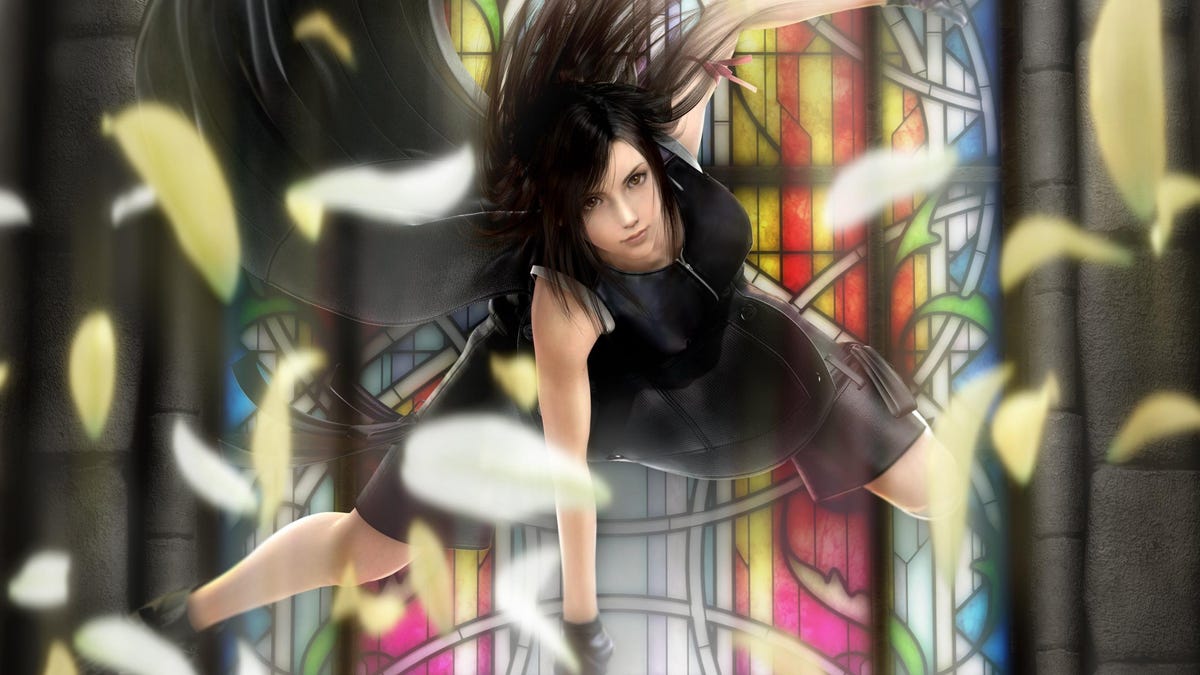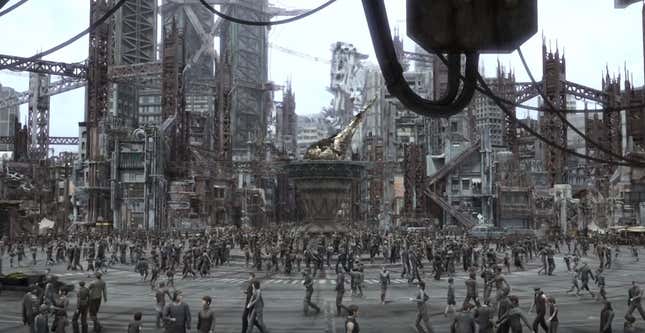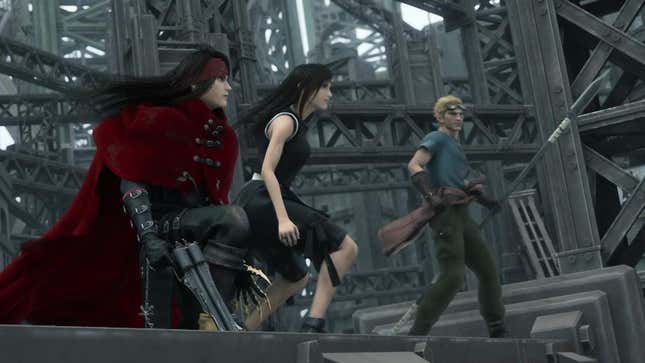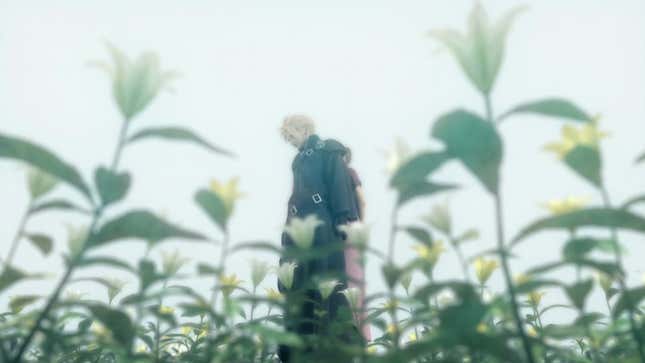
If you want to understand how the Final Fantasy VII universe got to where it is today, then you need not look any further than Advent Children. The 2005 animated movie that acts as a sequel to the original 1997 title is something of a flashpoint for the beloved characters. Advent Children paved the way for the once-concise events of a single game to branch off into spinoffs, prequels, sequels, and now a remake trilogy. It is the beginning of the franchise’s inability to let the original game stand on its own.
Ahead of Final Fantasy VII Rebirth’s release, Advent Children Complete—the extended version of the movie—re-released in theaters for a limited time. I went to a showing, and after playing Rebirth, I’m shocked by how much of the latest game’s events can be directly traced back to the movie. Advent Children is by no means good, but it remains one of the most important pieces of media for Final Fantasy VII and the Final Fantasy franchise at large.
This article contains spoilers for the original Final Fantasy VII and Advent Children.
Looking to the future of Final Fantasy
The first lines of dialogue in the film are a conversation between Rufus Shinra (he’s alive despite seemingly dying at the end of FF7, and just how is not explained) and new character Kadaj. “Why does humankind even bother?” Kadaj asks. “You wreck everything you’ve ever made, then you start over like it’ll be any different the next time.” To which Rufus replies, “I suppose we’re no good at facing our memories. We’d rather gild the past…Find something worthwhile among the rubble and build a future with that.”
When Advent Children first released eight years after FF7, it was pitched as an interesting sequel to the game. But in the context of the Remake trilogy, Rufus and Kadaj’s interaction and Advent Children at large hold so much more weight. Kadaj seems to almost question the developers behind the trilogy: “What is the purpose of this?”
Pre-order Final Fantasy VII Rebirth: Amazon | Best Buy | Target

In the Final Fantasy franchise, we rarely see what happens after our heroes save the world, but Advent Children shows us just that. Cloud has a boring day job and has settled into life with Tifa and their two adopted children, Marlene—who they watch while Barret is off doing something that the movie doesn’t explain—and newcomer Denzel. (Things being conspicuously unexplained is something of a recurring theme.) It’s a quiet life, but a good one. Too bad there is a mysterious plague called Geostigma making its way through the population. Not to mention the trio of Sephiroth wannabes (Kadaj, Los, and Yazoo) who appear, upending Cloud’s normal life and asking after their mother, Jenova, who very clearly died in FF7.
This bizarre plot point is mostly just an excuse to make the trio battle it out against the main party members in flashy fights. These fights, as well as the movie as a whole, are still a treat to look at even fifteen years later. Advent Children is the first (but not the last) movie made by Visual Works, Square Enix’s in-house cutscene maker now known as the Image Studio Division. This movie helped reimagine the game’s iconic characters more realistically, and the influence of this can be seen even in Rebirth.
The 3D models fly across the scene at high speeds and with shiny effects flashing off of weapons. It’s a lot of nonsense, but fun nonsense—especially in the film’s climactic battle between Cloud and Sephiroth which feels like it lacks any purpose beyond letting us see these two fight in 3D. The most interesting fight scene takes place in the middle of the film, when all of the party members unite in battle against Bahamut in the center of a newly built city on the outskirts of Midgar. It’s exhilarating to see them all fight together with their signature weapons and style, and you can clearly see how the film inspired the series’ transition to action combat.

Facing the past
A major issue with Advent Children is its pacing— an issue that the Remake trilogy also faces. The narrative is sparse and scenes stretch out for no reason at all. By the end, it feels like you can count the truly important moments on one hand with fingers to spare. But these crucial moments still hit hard, even bringing me to tears. Advent Children is concerned with Cloud’s survivor’s guilt and his inability to truly move on from the events of the game, which can feel a bit repetitive since this is somewhat addressed in the original FF7—but also, survivor’s guilt doesn’t just go away; it lingers. Advent Children also asks, what comes next? How will the next generation live? These questions are answered through Denzel and Marlene, who are clearly the torch holders for Aerith and Cloud respectively (even though Cloud is still alive). But the most interesting character in Advent Children is Tifa, whose growth since the events of the original game feels the most believable and well executed.
Tifa still fills the caretaker role we see in the original game, but in the movie she’s grown into more of a respected pillar of the community who is looked to for guidance. Her relationship with Cloud reflects their long history together, with the trials they faced in the game making them closer than ever. One particularly memorable moment comes when she confronts Cloud about his fear of being unable to save Marlene after she is kidnapped, a fear largely rooted in his failure to save Aerith two years before. “Maybe something will happen that can never un-happen. That scares you, doesn’t it? But you need to think about now.” It’s a somber moment that confronts Cloud’s guilt over Aerith’s death and his inability to let her death go. This is further punctuated by moments in which Cloud meets Aerith in the Lifestream, but still can’t bear to face her. Cloud, like Final Fantasy 7 as a brand itself, cannot let go of the past.

As one of the earliest entries in the Compilation of Final Fantasy VII, Advent Children is the beginning of a more convoluted expansion of the original game’s world. It begins the endless circling back to the same well that brings us to the remake trilogy existing. The question of whether or not it should have been made in the first place is now irrelevant. It exists, and FF7 as a brand must live with its decisions, good and bad.
One important moment, both dramatically and for its lore implications, shows Aerith and Sephiroth doing battle in the Lifestream, revealing how those who have passed on may still have an influence on the physical world. “I will never be a memory,” states Sephiroth at the end of his fight with Cloud, establishing that, like the characters and world of FF7, we will never be rid of him. This beloved story and everyone in it cannot just live in the past. And Sephiroth was correct in his statement, as the Remake trilogy revives him and the original game once more.
Advent Children is a mess of a story packed with unexplained expansions to the lore, over-the-top fights, and fan-service moments. But there are a handful of genuinely beautiful story beats that establish a dialogue between the film and the original game. It feels like a first run at the same themes we see at play in the Remake trilogy. Where the two connotations of the 1997 classic differ fascinates me even more. Advent Children closes by being a story of the future, not the past. Like the original game, it ends with the laughter of children, signaling hope for the next generation.
Yet, Advent Children also made it harder than ever to move on from the world and characters of FF7, which is antithetical to the story it’s trying to tell. The Remake trilogy understands that, because of Advent Children, Final Fantasy 7 can never escape its own past. But rather than “gild the past” as Rufus puts it, offering a more conventional video game retelling that pretties up the original game while smoothing away its edges in hopes of becoming the game fans think they remember and love, Remake and its sequels attempt to take on the challenge of facing the complex, messy reality of our collective memories.








